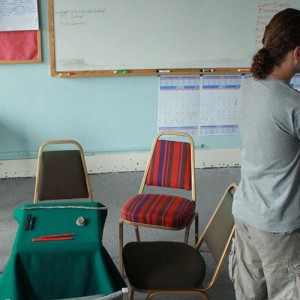1 hr, 7 minutes, 6 seconds.
[Note: This podcast isn’t designed to teach Chinuk Wawa. It is a demonstration of how to apply the WAYK method to an endangered language. By listening to it, you will improve your understanding of WAYK techniques, but you won’t receive any instruction in Chinuk specifically.]
In this episode, Evan debriefs the first game that Kirstyn Walker (a Chinuk Wawa night attendee and volunteer at Fort Vancouver in Washington State) has led, in sharing Chinuk. Later, Evan and Willem resume their regular debrief how the evening of Chinuk Wawa conversation went.
1. Technique “No-grief Debrief“
- Kirstyn’s “limited” objects: Needle, Thread, Scissors, Stone.
- Kirstyn played all the way to “Want/Have/Give/Take“.
- There is a deaf school nearby; Kirstyn’s volunteer players will now be able to speak with them, with their new (though humble) ability to fluently sign “want/have/give/take“.
- They discuss how one chooses the “limited” objects in a WAYK game.
2. Techniques “Let it go” and “How Fascinating!”
- Kirstyn encourages one of her players to use “How Fascinating!“. The beatings will continue till morale improves!
3. Technique “Technique!“
- Kirstyn: “these techniques are good for everything; they create a culture of learning.”
- How Kirsten first discovered the WAYK techniques; this is a good example of how Chinuk Wawa WAYK players, owing to the fact that WAYK has slowly developed around them, have had a different experience of the game than newer folks, with less overt training in “language hunting” and the WAYK technique mentoring language. This is now finally changing!
4. Technique “Limit“
- Kirstyn resolves to enforce “limit” more rigorously for her next game.
5. Technique “Look in the bag“
- Kirstyn’s best moment: when a 9 year old player kept speaking on her own (“Then I want your stone…”) even after Kirstyn finished the game and turned away.
6. Evan and Willem start their debrief of the night, with Technique “the Walk“.
- Creating “the Walk” through the eyes of “Obviously!“.
- The fun of WAYK masks the tremendous engineering involved in designing the game environment.
- Fall in love with the craft of “Language Hunting”, not just with how much language you “know”.
7. Technique “Travels with Charlie“
- The ACTFL proficiency cards.
- Evan recommends, for anyone interested in a more in-depth understanding of the ACTFL proficiency scale, that they attend the high-quality ACTFL week long workshop.
8. Technique “Riddle me this…“
- Ryan, a WAYK workshop veteran, drops in for his 3rd, half-hour visit to Chinuk Wawa.
- Willem gave Ryan two new pieces of language structure, roughly equivalent to “back” (as in “give it back to me”), and “which” (as in “the pen which is sitting on the table, which is in this room”).
- Ryan’s “Oh, okay, yeah!” moment when learning to fluently wield “back”.
- Dealing with the decelerating “urge to translate” your target language into English (i.e. your mother tongue).
9. Techniques “Total Physical Response“ and “Set-up“
- Protect your “oh, okay, yeah!” moments. Don’t fall prey to “the urge to translate”!
- Ryan’s WAYK training in “language hunting” has already caught him up, after one and a half total hours, with some of the longer-term Chinuk Wawa speakers who come to conversation night. Yes, it boggles the mind. It is amazing what a well-trained “language hunter” can do, even with only two days of WAYK immersion at a workshop.
10. Technique “Bite-sized Pieces“
- How many more Chinuk Wawa games will Willem run with Ryan before having him begin leading Chinuk games for other speakers?
- We don’t endorse or appreciate “trophy hunting” languages. It doesn’t impress us. To impress us, show us you can teach others to teach your languages.
11. Technique “Language Hunting“
- The importance of “language hunting” for it’s own sake, to hone your skill at the craft, rather than just acquiring new language ability. Learn any language, anywhere, anytime you can, not just your favorite languages.
- Ryan is a Montessori teacher for a diverse ethnic population of multlingual 9-10 year olds. Evan’s mind boggles at the opportunity.
- The enormous language ability of 9-10 year olds, specifically.
- The first step in “language hunting” is a big one. Employing technique “Obviously!“, in a real-world situation, is not so obvious.
- Evan watched too many ninja action movies during the 1980’s.
12. Technique “We’ll All Get There Together“
- Willem: “At the end of the night, they don’t want to leave…”
13. Technique “the Walk“
- For the first time at Chinuk, the community took over “the Walk” together, leaving Evan to fade into the background. We’ve reached critical mass of trained WAYK players.
14. Technique “Fluent Fool“






Lots of techniques this time. Are techniques the same as “patterns”, as the term is used by GoF, C2 Wiki, and elsewhere? (I found http://www.wikipatterns.com today, for example).
If so, should there a name for Anti-Patterns (http://c2.com/cgi/wiki?AntiPattern). “Sorry Charlie” is one. I propose “Trophy Hunter” to go with it.
Yes, techniques are “patterns”, as originally conceived by Christopher Alexander in his book “a Pattern Language” (a book of architectural “patterns”), and then subsequently adopted by the software community and others, like the wikipatterns folks.
In our developing language for speaking about techniques, since each technique is an independent “accelerator” (and is used for no other reason than its ability to do so), “antipattern” techniques are “decelerators”.
So, investing in the education of a “trophy hunter” will literally slow down the progress of your community in maintaining or acquiring fluent proficiency.
So, “trophy hunter” would make a fine name for a decelerator/antipattern.